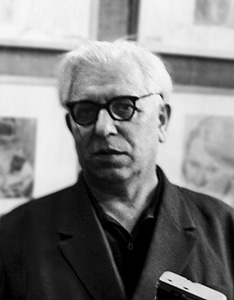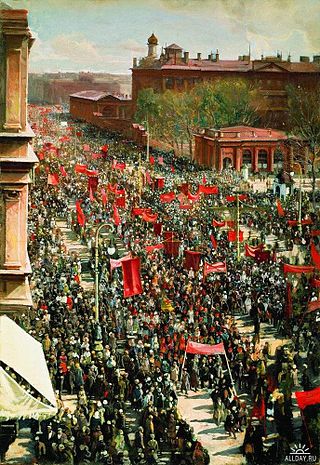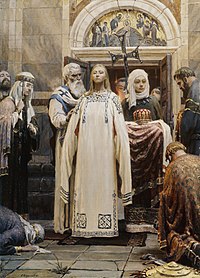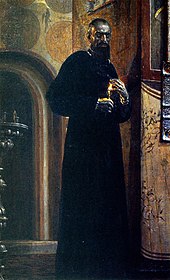
Andrei Rublev was a Russian artist considered to be one of the greatest medieval Russian painters of Orthodox Christian icons and frescoes. He is revered as a saint in the Eastern Orthodox Church, and his feast day is 29 January.

Sophia Fominichna Palaiologina or Paleologue was a Byzantine princess from the Palaiologos imperial dynasty and the grand princess of Moscow as the second wife of Ivan III of Russia. Her father was Thomas Palaiologos, the despot of the Morea. Through her eldest son, Vasili III, she was the grandmother of Ivan IV, the first crowned tsar of all Russia.

The Trinity Lavra of St. Sergius is a lavra and the most important Russian monastery, being the spiritual centre of the Russian Orthodox Church. The monastery is situated in the town of Sergiyev Posad, about 70 kilometres (43 mi) to the northeast from Moscow by the road leading to Yaroslavl, and currently is home to over 300 monks.

Sergius of Radonezh was a spiritual leader and monastic reformer of medieval Russia. Together with Seraphim of Sarov, he is one of Eastern Orthodoxy's most highly venerated saints in Russia.

The State Tretyakov Gallery is an art gallery in Moscow, Russia, which is considered the foremost depository of Russian fine art in the world.

Kirillo-Belozersky Monastery, known in English as White LakeSt. Cyril's Monastery, is a Russian Orthodox monastery in Kirillov, Russia. It used to be the largest monastery and the strongest fortress in Northern Russia.

Mikhail Vasilyevich Nesterov was a Russian and Soviet painter; associated with the Peredvizhniki and Mir iskusstva. He was one of the first exponents of Symbolist art in Russia.

The Trinity is an icon created by Russian painter Andrei Rublev in the early 15th century. It is his most famous work and the most famous of all Russian icons, and it is regarded as one of the highest achievements of Russian art. Scholars believe that it is one of only two works of art that can be attributed to Rublev with any sort of certainty.

Arseny Nikiforovich Semionov was a Soviet painter and art teacher, lived and worked in Leningrad, a member of the Leningrad Union of Artists, regarded as one of the representatives of the Leningrad school of painting, most famous for his landscape and cityscape paintings.

Dmitry Ivanovich Maevsky was a Soviet Russian painter, lived and worked in Leningrad, a member of the Leningrad Union of Artists, regarded as one of the representatives of the Leningrad school of painting, most famous for his lyrical landscapes.

Vladimir Alexandrovich Gorb was a Soviet Russian painter, graphic artist, and art teacher. He lived and worked in Leningrad as professor of the Repin Institute of Arts, was awarded the title of Honored Art Worker of Russian Federation, and was member of the Leningrad branch of Union of Artists of Russian Federation. He is regarded as a representative of the Leningrad school of painting, most famous for his portrait paintings and Art teaching.
The year 1960 was marked by many events that left an imprint on the history of Soviet and Russian Fine Arts.

The Leningrad School of Painting is a phenomenon that refers to a large group of painters who developed in Leningrad around the reformed Academy of Arts in 1930–1950 and was united by the Leningrad Union of Soviet Artists (1932–1991).
The year 1952 was marked by many events that left an imprint on the history of Soviet and Russian Fine Arts.

The Second National Art Exhibition "Soviet Russia" was one of the largest Soviet art exhibitions of the 1960s. The exhibition took place in Manezh Exhibition Hall.

Third National Art Exhibition "Soviet Russia" became a main national art event of 1967, as well as one of the largest Soviet art exhibitions of the 1960s. The exhibition took place in Manezh Exhibition Hall.

Exhibition of Leningrad artists of 1960 become one of the largest Soviet Art Exhibition of 1960 year. The Exhibition took place in State Russian Museum.

The fine art of Leningrad is an important component of Russian Soviet art—in the opinion of the art historians Vladimir Gusev and Vladimir Leniashin, "one of its most powerful currents". This widely used term embraces the creative lives and the achievements of several generations of Leningrad painters, sculptors, graphic artists and creators of decorative and applied art from 1917 to the early 1990s.

Ivan the Terrible and His Son Ivan on 16 November 1581 is a painting by Russian realist artist Ilya Repin made between 1883 and 1885. It depicts the grief-stricken Russian tsar Ivan the Terrible cradling his dying son, the Tsarevich Ivan Ivanovich, shortly after Ivan the Terrible had dealt a fatal blow to his son's head in a fit of anger. The painting portrays the anguish and remorse on the face of the elder Ivan and the shock and heartbreak of the dying Tsarevich, shedding a tear at the unexpected betrayal and shock of having been killed by his father's hands.
Godunov is a Russian historical drama television series created by Ilya Tikin and Nikolay Borisov, directed by Alexei Andrianov and Timur Alpatov. The first season premiered from November 5 to November 8, 2018 on the "Russia-1" national TV channel. The second season premiered from March 25 to March 29, 2019.






















